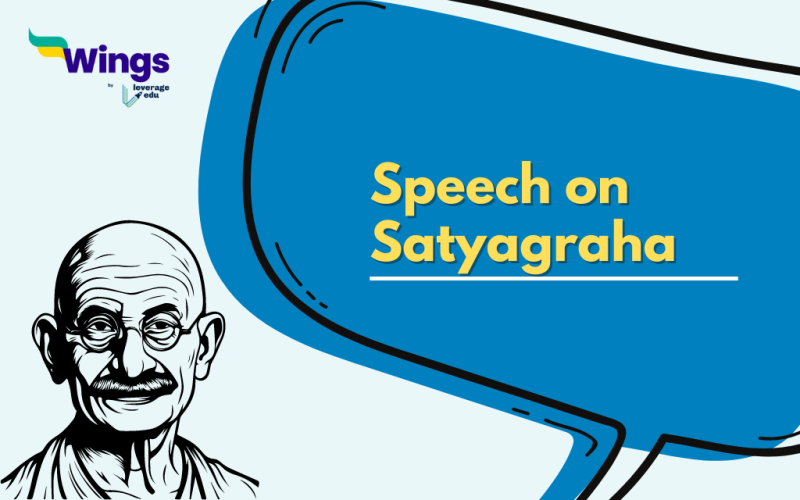A very warm welcome to the respected authorities and my fellow friends. Today, I am standing before you all to deliver my speech of thoughts on the topic Speech on Satyagraha—The Power of Truth and Nonviolent Resistance.
Dear gathered people, what would be your reply after listening to the word Satyagraha? Most probably, you must be struck by the philosophy of non-violence and its practitioner, our father of the nation, Mahatma Gandhi. But do you know what the word Satyagraha exactly means?
The word Satyagraha comes from the Sanskrit word ‘Satya’, which means truth, and ‘Agraha’ means firmness or insistence. Thus, the basic core idea behind Satyagraha is holding firmly the truth and refusing to cooperate with injustice.
Gandhi always believed that true satyagraha comes not from physical force but from one´s moral courage and commitment to what is correct. The basic principle on which Satygrah is based on in ahimsa, or non-violence. Here, non-violence means refusing to harm others, even in the case of provocation. Doesn´t it sound great? Indeed.
My dear friends, going back in history, we can see that Satyagraha played an important role in the fight for independence from the British. Bapu used this powerful tool of philosophy to organize a series of non-violent protests. Furthermore, his civil disobedience campaigns were yet another example that helped to weaken the foundations of colonial government.
How can we forget the most famous example of the Dandi March of 1930? Gandhi led a group of followers to the coastal town of Dandi, refusing to obey the British salt monopoly. This one act of non-violence sparked the entire nation and inspired thousands of Indians to join the struggle for freedom.
Another example of Satyagraha from our days of slavery was the Quit India Movement in 1942. Can you believe that using the tool of Satyagraha, Mahatma Gandhi roared at the Britishers to leave India? This movement helped to crack down on the authorities and demonstrated the determination of Indians to achieve Independence.
This is not all. The strong impact of satyagraha has crossed borders and spread worldwide, further inspiring civil rights movements and social justice efforts worldwide. Some examples of the fame of the power of truth and non-violent resistance can be found in the United States, where revolutionary Martin Luther King Jr. followed the principle of Satyagraha.
The king’s well-known Montgomery bus boycott and his “I Have a Dream” speech were significantly influenced by the satyagraha movement.
Similarly, the anti-apartheid movement in South Africa, led by famous figures like Nelson Mandela, challenged the oppressive white minority government.
Coming to our modern era and the global world, Satyagraha still holds its firm root. People with revolutionary ideas who face climate change, economic inequality, political polarisation, and much more practice satyagraha to let the world hear their voices.
‘Listeners, Satyagraha teaches us that true change comes not from violent acts but from a steadfast commitment to truth and justice. It reminds us that powers can be transformed through peaceful collective action.’
‘Embracing the philosophy of satyagrah, we all can become agents of change. While working together peacefully, build a better tomorrow for ourselves and for the generations to come.’
Thank you!
Quick Read: Speech on Nurse: Short and Long Speech
Quick Read: World Health Day Speech: 07 April
Speech on Satyagraha: The Power of Truth and Nonviolent Resistance in 10 Lines
Let us understand the Speech on Satyagraha in short and simple 10 points:
1. Satygraha is a powerful idea that helped India win freedom from the British.
2. It was developed by the great leader Mahatma Gandhi, who believed in non-violence.
3. Satyagraha means firmly holding the truth without using violence.
4. Gandhi used the tool of Satyagraha to organise peaceful protests and civil disobedience against the British and their policies.
5. The best example of Satyagraha is Dandi March, where Mahatma Gandhi walked to the sea to make salt. This was a way to show protest against British Laws.
6. Many people got inspired by this non-violent protest and practiced it in their real lives to fight for their rights.
7. Mahatma Gandhi and his followers refused to accept injustice and showed moral courage regarding this.
8. Satyagraha inspired many other movements worldwide for justice and freedom.
9. Even in the modern era, people follow the practice of satyagraha and use the weapon to stand up for what is right.
10. Satyagraha teaches us that real change can come merely from commitment to truth and not from violence.
Also Read: Speech on AI in English for School Students: Check Samples
Also Read: Speech on the Future of Capitalism for School Students
FAQs
Ans. Satyagraha is a form of nonviolent civil disobedience. It was developed by Mahatma Gandhi, the famous Indian leader. Satyagraha means “holding on to the truth” in Sanskrit. The main idea is to resist injustice without using violence. Satyagraha is practised by peaceful protests, marches, and other nonviolent actions to bring about change.
Ans. Satyagraha is the idea of firmly holding on to the truth and refusing to cooperate with injustice, without using violence. It was key to India’s fight for independence
Ans. The main principles of satyagraha are non-violence, truth, and willingness to suffer for a cause.
Popular Speech Topics
This was all about the Speech on Satyagraha: The Power of Truth and Nonviolent Resistance For more information on such interesting speech topics for your school, visit our speech writing page and follow Leverage Edu.
 One app for all your study abroad needs
One app for all your study abroad needs













